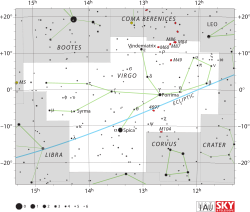Rijl al Awwa
| Rijl al Awwa (μ) | |
 | |
| Observationsdata Epok: J2000.0 | |
|---|---|
| Stjärnbild | Jungfrun |
| Rektascension | 14t 43m 03,62282s[1] |
| Deklination | -05° 39′ 29,5327″[1] |
| Skenbar magnitud () | 3,88[2][3] |
| Stjärntyp | |
| Spektraltyp | F2 V[4] |
| U–B | -0,04[2] |
| B–V | +0,39[2] |
| Astrometri | |
| Radialhastighet () | 5,10 ± 0,7[5] km/s |
| Egenrörelse (µ) | RA: +103,28[1] mas/år Dek.: -318,63[1] mas/år |
| Parallax () | 54,73 ± 0,20[1] |
| Avstånd | 59,6 ± 0,2 lå (18,27 ± 0,07 pc) |
| Absolut magnitud () | 2,57[3] |
| Detaljer | |
| Radie | 1,99[6] R☉ |
| Luminositet | 7,474[7] L☉ |
| Temperatur | 6 751[4] K |
| Metallicitet | -0,05[4] |
| Vinkelhastighet | 47,0[8] km/s |
| Ålder | 1,5[3] miljarder år |
| Andra beteckningar | |
| 107 Virginis, BD- 0553936, FK5 545, GJ 9491, HD 129502, HIP 71957, HR 5487, SAO 140090.[9] | |
Rijl al Awwa eller My Virginis (μ Virginis, förkortat My Vir, μ Vir) som är stjärnans Bayerbeteckning, är en stjärna belägen i östra delen av stjärnbilden Jungfrun. Den har en skenbar magnitud på +3,88[2] och är väl synlig för blotta ögat. Stjärnans position nära himmelsekvatorn innebär att den är synlig från de flesta platser på jorden. Baserat på parallaxmätning inom Hipparcosuppdraget på ca 55 mas,[1] beräknas den befinna sig på ett avstånd av ca 60 ljusår (18 parsek) från solen.
Nomenklatur
[redigera | redigera wikitext]My Virginis var listad i Al Achsasi al Mouakket-kalendern som rijl al-'awwa', arabiska رجل العوى, vilket betyder "inroparens fot (hund)".[10]
Egenskaper
[redigera | redigera wikitext]Rijl al Awwa är en blå till vit stjärna i huvudserien av typ F och av spektralklass F2 V,[4] även om den visar tecken på att vara en mera utvecklad stjärna.[6] En studie år 1990 av stjärnan gav den en klassificering som jättestjärna och beräknade dess storlek till 1,7 gånger solens massa och 2,1 gånger solens radie och 9,8 gånger solens ljusstyrka.[11] Den utsänder från sin yttre atmosfär 7,5 gånger mer energi än solen vid en effektiv temperatur på 6 750[4] K. Stjärnans beräknade ålder är 1,5 miljarder år och den har en relativt hög projicerad rotationshastighet på 47,0[8] km/s.
Tidigare observationer av Rijl al Awwa tyder på indikationer på kortvarig variabilitet i kromosfären såväl som variationer av radialhastigheten.[6] Den har en kandidat till följeslagare med en projicerad separation av 770 AE. Detta objekt har en storlek på magnitud 10,72 i J-bandet.[12]
Källor
[redigera | redigera wikitext]- Den här artikeln är helt eller delvis baserad på material från engelskspråkiga Wikipedia, tidigare version.
Referenser
[redigera | redigera wikitext]- ^ [a b c d e f] van Leeuwen, F. (2007), "Validation of the new Hipparcos reduction", Astronomy and Astrophysics, 474 (2): 653–664, Bibcode:2007A&A...474..653V, arXiv:0708.1752 Freely accessible, doi:10.1051/0004-6361:20078357.
- ^ [a b c d] Mermilliod, J.-C. (1986), "Compilation of Eggen's UBV data, transformed to UBV (unpublished)", Catalogue of Eggen's UBV data, SIMBAD, Bibcode:1986EgUBV........0M.
- ^ [a b c] Holmberg, J.; et al. (July 2009), "The Geneva-Copenhagen survey of the solar neighbourhood. III. Improved distances, ages, and kinematics", Astronomy and Astrophysics, 501 (3): 941–947, Bibcode:2009A&A...501..941H, arXiv:0811.3982 Freely accessible, doi:10.1051/0004-6361/200811191.
- ^ [a b c d e] Gray, R. O.; et al. (July 2006), "Contributions to the Nearby Stars (NStars) Project: spectroscopy of stars earlier than M0 within 40 pc-The Southern Sample", The Astronomical Journal, 132 (1): 161–170, Bibcode:2006AJ....132..161G, arXiv:astro-ph/0603770 Freely accessible, doi:10.1086/504637.
- ^ Gontcharov, G. A. (November 2006). "Pulkovo Compilation of Radial Velocities for 35,495 Hipparcos stars in a common system". Astronomy Letters. 32 (11): 759–771. Bibcode:2006AstL...32..759G. doi:10.1134/S1063773706110065.
- ^ [a b c] Rachford, Brian L.; Foight, Dillon R. (June 2009), "Chromospheric Variability in Early F-Type Stars", The Astrophysical Journal, 698 (1): 786–802, Bibcode:2009ApJ...698..786R, arXiv:0904.1620 Freely accessible, doi:10.1088/0004-637X/698/1/786.
- ^ Moro-Martín, A.; Marshall, J. P.; Kennedy, G.; Sibthorpe, B.; Matthews, B. C.; Eiroa, C.; Wyatt, M. C.; Lestrade, J.-F.; Maldonado, J.; Rodriguez, D.; Greaves, J. S.; Montesinos, B.; Mora, A.; Booth, M.; Duchêne, G.; Wilner, D.; Horner, J. (2015). "Does the Presence of Planets Affect the Frequency and Properties of Extrasolar Kuiper Belts? Results from the Herschel Debris and Dunes Surveys". The Astrophysical Journal. 801 (2): 143. Bibcode:2015ApJ...801..143M. doi:10.1088/0004-637X/801/2/143.
- ^ [a b] Schröder, C.; et al. (January 2009), "Ca II HK emission in rapidly rotating stars. Evidence for an onset of the solar-type dynamo", Astronomy and Astrophysics, 493 (3): 1099–1107, Bibcode:2009A&A...493.1099S, doi:10.1051/0004-6361:200810377.
- ^ "mu. Vir -- High proper-motion Star", SIMBAD Astronomical Database, Centre de Données astronomiques de Strasbourg, hämtad 2016-09-08.
- ^ Allen, R. H., (1963). Star Names: Their Lore and Meaning (Reprint ed.). New York, NY: Dover Publications Inc. p. 473. ISBN 0-486-21079-0.
- ^ Malagnini, M. L.; Morossi, C. (November 1990), "Accurate absolute luminosities, effective temperatures, radii, masses and surface gravities for a selected sample of field stars", Astronomy and Astrophysics Supplement Series, 85 (3): 1015–1019, Bibcode:1990A&AS...85.1015M.
- ^ Chini, R.; et al. (January 2014), "New visual companions of solar-type stars within 25 pc", Monthly Notices of the Royal Astronomical Society, 437 (1): 879–886, Bibcode:2014MNRAS.437..879C, arXiv:1310.2684 Freely accessible, doi:10.1093/mnras/stt1953.





